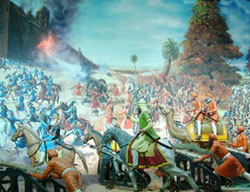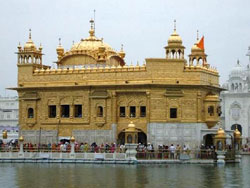The Campaign of Amritsar
Amritsar is the spiritual capital of the Sikhs. A holy tank was got dug by Guru Ram Dass and the temple was built by Guru Arjan Dev, who installed Guru Granth Sahib in it. Akal Takht was built by Guru Hargobind. It was the seat of temporal authority. The Guru hinself sat there and held a court of justice. Many Sikhs used to gather there for the redress of their grievances. Gurmattas were passed which were binding on the Sikhs.
Guru Arjan Dev proclaimed the benefits of he holy tank at Amritsar. "all the sins that a man committeth are washed away by bathing in the Tank of Ram Das."

It was must for every true Sikh to take a dip in the holy tank. Moreover, Amritsar was the biggest trade centre of Punjab. Goods from central Asia were exchanged here for the local goods. Silk, Muslin, Spices, tea, hides, and several other articles were bought and sold here. For the Sikhs Amritsar was the Mecca Singh Amritsar was divided among a dozen families manning different parts of the city.
In each of these parts they had built for themselves small fortresses and maintained a task force of tax collectors who sometimes forcibly collected money from the trading community. These tax collectors very often quarelled among themselves and sometimes even created scenes in the streets to the amazement of the residents. The citizens could not stand such a situation for long and secretly approached Maharaja Ranjit Singh to invite him to attack the city. It was reported to Ranjit Singh that there was hardly any unity among these Sardars. The only formidable family was that of Mai Sukhan, widow of the Bhangi chief, Gulab Singh. She was in possesion of the Gobindgarh fort. According to Lepel Griffin, Ranjit Singh demanded from Mai Sukhan the famous Bhangi Gun, Zamzama, made of copper and Brass, which had caused disaster among the rank and file of the Marathas at the third battle of Panipat. It was captured from the Duranis in 1764 by the Bhangis and it was because of this reason that it was known as Bhangian Di Tope.

Thus in 1802, Maharaja Ranjit Singh marched towards, Amritsar at the head of the force consisting of Kanahaiya, Nakkai and Ahluwalia troops in addition to his own force in strength. When the troops reached Amritsar, the Rani closed the gates of the town, mounted the ramparts of the city with arms and ammunition in considerable quantity and gave the attacking army a very good recetion. Fateh Singh Ahluwalia, commenced his operations in front of the Bridge gate and the Maharaja on the other end of the Lohgarh fort. A fierce fighting took place but in the end the gates could not stand the heavy cannonade and the marching army entered city in triumph, with the Maharaja at the head. Ranjit Singh ordered that the city should not be plundered as the place was too sacred with the memory of the Gurus. The fort of Lohgarh was besieged without any difficulty. As a coincidence, there was heavy rain during the dy and the Rani and her son had no place to take shelter. They went to the haveli of Sardar Jodh Singh Ramgarhia, who took pity on them and gave them shelter. Ranjit Singh Sanctioned a small jagir for them for their maintenance. The confederacy collapased. Ranjit Singh occupied the fort and captured considerable war material,including the Zamzama and the area which yielded a handsome revenue.
More important than the capture of the fort was the acquisition of the services of the gallant warrior, Akali Phula Singh. He belong to the militant order of the Nihangs and had devoted his life to the protection of the Sikh shrines. He rendered necessary help to the Maharaja in capturing the city of Amritsar. With him were about three thousand Nihangs who wanted to join the army of the Maharaja. The Akali prooved to be a great asset to the Maharaja in capturing territories later on. He died a heroic death in the battle of Naushera. He was a man of such a forceful will and character that at one time he decoyed even Maharaja Ranjit Singh to undress and get flogged on his naked body before the holy Akal Takht. With a person of such a high stature as the Maharaja himself accepting the punishment awarded, the Akal Takht gained a dignity and prestige among the Sikhs who henceforth came to seek a pardon here.
Akali Phoola Singh, though a soldier of zeal and valour, sometimes acted according to his own whims. Since 1800, the management of the holy shrines passed into the hands of the Akalis under the supervision of Akali Phula Singh. In 1815 he reached Amritsar with some of his devotees and out of Rs 1,100 collected as contribution at Darbar Sahib, he claimed Rs 1000. It was Baisakhi day. He picked quarrel with his rivals and in the ensuing encounter there were three casualties. The matter was reported to Ranjit Singh who ordered Hakim Imam-Ud-Din to settel the dispute.

Ranjit Singh,the victor, paid a visit to Hari mandir as a humble man and performed his ablutions in the holy tank. The capture of the Amritsar brought fame and honour to Ranjit Singh. Ranjit Singh was such a devoted Sikh that instead of putting his name on the coin issued by his government he put the word "akal Sahai", means the great God, as seen in this coin. Many Indians from the force of East India company started joining the ranks of his family. As many sardars of the Bhangi famiy had joined the Maharaja army, they were required to furnish well-ewuipped soldiers at times of war. The total fighting force which could be utilised on any occasion was 31,000. Ranjit Singh appointed Misar Chajju Mal as the collector of Customs at Amritsar. The Misar was extremely loyal to Maharaja and rendered him useful service. Ranjit Singh took keen interest in the management of the holy shrine. He appointed Surat Singh as its Manager. He gave shrine its marble face and its golden look from which the name Golden Temple or Swarn Mandir is derived. Marble and fresco paintings were also added. The eastern loggia of the shrine was gilded by Rani Sada kaur at a cost of Rs. 1,75,300 . Amritsr's gaiety and splendour increased. It was inhibited by aristocracy and many high dignitaries often visited the town. It was illuminated on special occasins. There were rejoicings in the city and it gave a festive appearance and whenever the Maharaja was victorious in any campaign, large scale celebrations were held.
